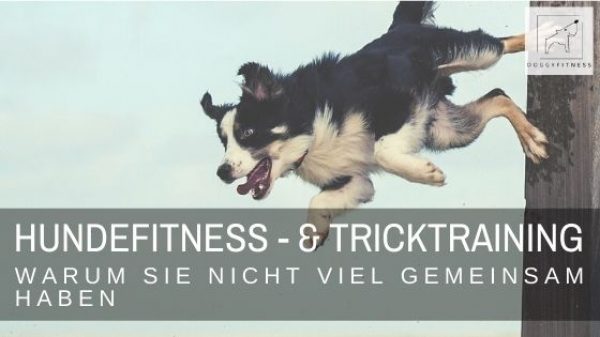Lately I have been asked more often where the difference is between dog fitness training or exercise training and trick training. Basically, the two don’t really have much to do with each other, or the goal and focus are completely different. Trick training is primarily about “fun”, hobby, occupation, and exercise. This is not meant to sound pejorative – on the contrary – it is highly challenging for the dogs and impressive what many dogs learn. But it’s just about learning tricks. Exercise training is about learning specific movements and the focus is solely on the health aspect.
The goals of exercise training dog fitness training
It’s about healthy movements and movement patterns, good body awareness, even muscling, flexibility and coordination.
How do you achieve this?
The first step is to implement this with everyday movements. Because already there it hapert with most quadrupeds – also with the healthy dogs. Many dogs do not have a good perception of their own body. If we were to approach this with highly complex movements, it would only lead to tension, but not to a better perception of our own body and our own movement sequences. It is important that movements are performed consciously and purposefully by the dog. These are also often small movements that are very selective.
Everyday movements such as correct sitting, standing and also lying down are often neglected dog fitness training
I have already written in another article about the fact that many dogs can not sit “correctly”. This is such a classic, just like standing or lying down. Have you ever paid attention to how your dog sits? You can observe in many dogs that they often slide their butts to the side in the sit, angle a run, and sit like a gulp of water in the turn. This is not only the case with older dogs or dogs with joint disease, but also with healthy dogs and sporting dogs. It’s just convenient. The way we often didn’t sit straight when we were teenagers. If a dog learns to perform basic movements consciously and correctly, and with further movement exercises, all of which should be performed slowly, then this will have an influence on his overall locomotion. Dog fitness training
Also in sports. The dog has better posture, body tension and body awareness. This allows him to use his body in sports much better and more targeted. As a result, he is more efficient but also the risk of injury is minimized.
I have many sporting dogs and sporting dog owners in my courses who then ask me why the dog should do a stand sit transfer as an exercise – he can do everything already. But when I then ask the course participants to film the dog during the movements and we watch and analyze this together, you can see how many dogs still have a lot of potential here to optimize their movement sequences. The devil is often in the details. Over time, you will suddenly notice that the dog begins to change in the sport and uses his body differently.
Dog fitness is not about entertainment
Our dogs enjoy the exercise training. I haven’t actually seen a dog in the last almost three years that wasn’t having fun. I have to say clearly that it is important for the training that the dog participates with joy. But the reason we train with him is neither entertainment nor to teach him “creative” movements. It’s more about specifically promoting optimal movements, whether I’m restoring those or working preventively. Dog fitness training
But some exercises from trick training are also good for the dog’s fitness, right?
Most definitely even! Often the mobility is promoted and also the balance. But that is simply not the focus of trick training. Accordingly, no attention is paid to certain training patterns that have a positive effect on fitness.
This is important in dog fitness training
In dog fitness – training, exercises are specifically selected according to training effects and combined with each other. As required by the needs of the dog. We always take into account whether we are training a sporting dog, an older dog, a dog whose basic fitness we want to promote as a preventive measure, a young dog or a dog with joint diseases. Training should be done according to a training plan, so that the training also has a common thread. It’s about a whole body workout – which has physical focuses depending on the situation – but basically always includes the whole body in the workout. In addition, it is also important that it is always a healthy mix of muscle training, promoting flexibility, stretching, coordination and body awareness training. The condition should also be taken into account. So, in sum, it makes the combination of exercises that target the different areas of the body, but also the different aspects of a fitness workout. This all needs to be coordinated in a sensible way. These factors also do not play an overriding role in trick training.
You see, trick training and dog fitness training are thematically far apart and have a very different focus. By the way, I think trick training is a really great way to exercise dogs – even if they are older or have joint problems. Dog fitness training
All love,
your Tina
Dieser Beitrag ist auch verfügbar auf:
Français (French)
Deutsch (German)
Español (Spanish)
















